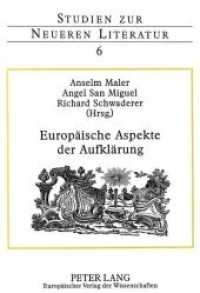Full Description
This book addresses how language is conceptualised in Australian schooling
to deliver a better understanding of how multilingualism can be incorporated
into everyday teaching and learning, practice, and policy.
By integrating different educational domains - namely, subject English,
teaching English to speakers of other languages (TESOL), Languages as a
subject area, and the learning of languages across the curriculum - the text
(re-)frames language(s) learning for all students, including first-generation
immigrants, international students, students born in Australia to immigrant
parents, Indigenous students, and students with no exposure to other languages at home. It
is distinctive in that it brings together scholars from across the L1 and L2
fields. Presenting a novel framework that addresses the positioning of both
language and opportunity across different domains at school, this book offers
a multilingual vision for all teachers. The Australian setting depicted serves as
a rich example for similar contexts worldwide.
This is an invaluable resource for students and academics in disciplines
related to language(s) and education, as well as teacher educators, school
leaders, and practitioners.
Contents
1. Introduction: English, Language(s), and Australian Education
Part One
2. Exploring Context and Possibility in Education Through the Understanding and Undoing of Language
3. On Language and Hospitality: A Practice-Ontological Perspective
4. English in Australia - A Multilingual Subject?
5. Home Languages are Everyone's Business
Part Two
6. Subject English, Multilingualism and Critical Cultural Studies: Relanguaging English Education in Australia towards Postcolonial Possibility
7. Teaching Literature in the Contact Zone: Knowledge, Language and Meaning-Making in Plurilingual Classrooms
8. From EAL Students to Multilingual Learners: Privileging Existing Language Knowledge in Australian Classrooms
9. Rethinking Digital Multimodal Composing by Embracing Linguistic and Cultural Diversity in the Classroom
Part Three
10. 'Teachers as Co-Learners' of Languages: Recurricularising Language and Literacy Learning as a Multilingual and Collaborative Endeavour
11. Bringing Reciprocal Multilingual Awareness to Australian Language(s) Education
12. Teaching about Honeybees: Embracing Indigenous Language, Culture, and Content through 'On Country Learning'
13. Multilingualism and Intercultural Development: Transformative Identity within Languages Curriculum
14. Conclusion: Multilingualism as Opportunity







